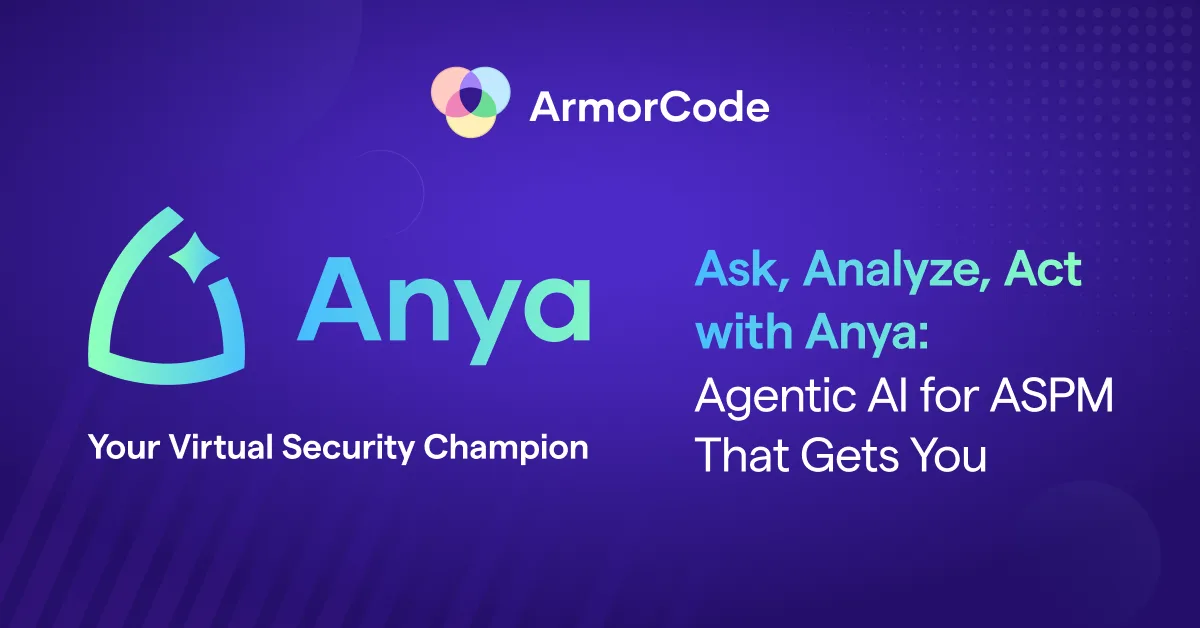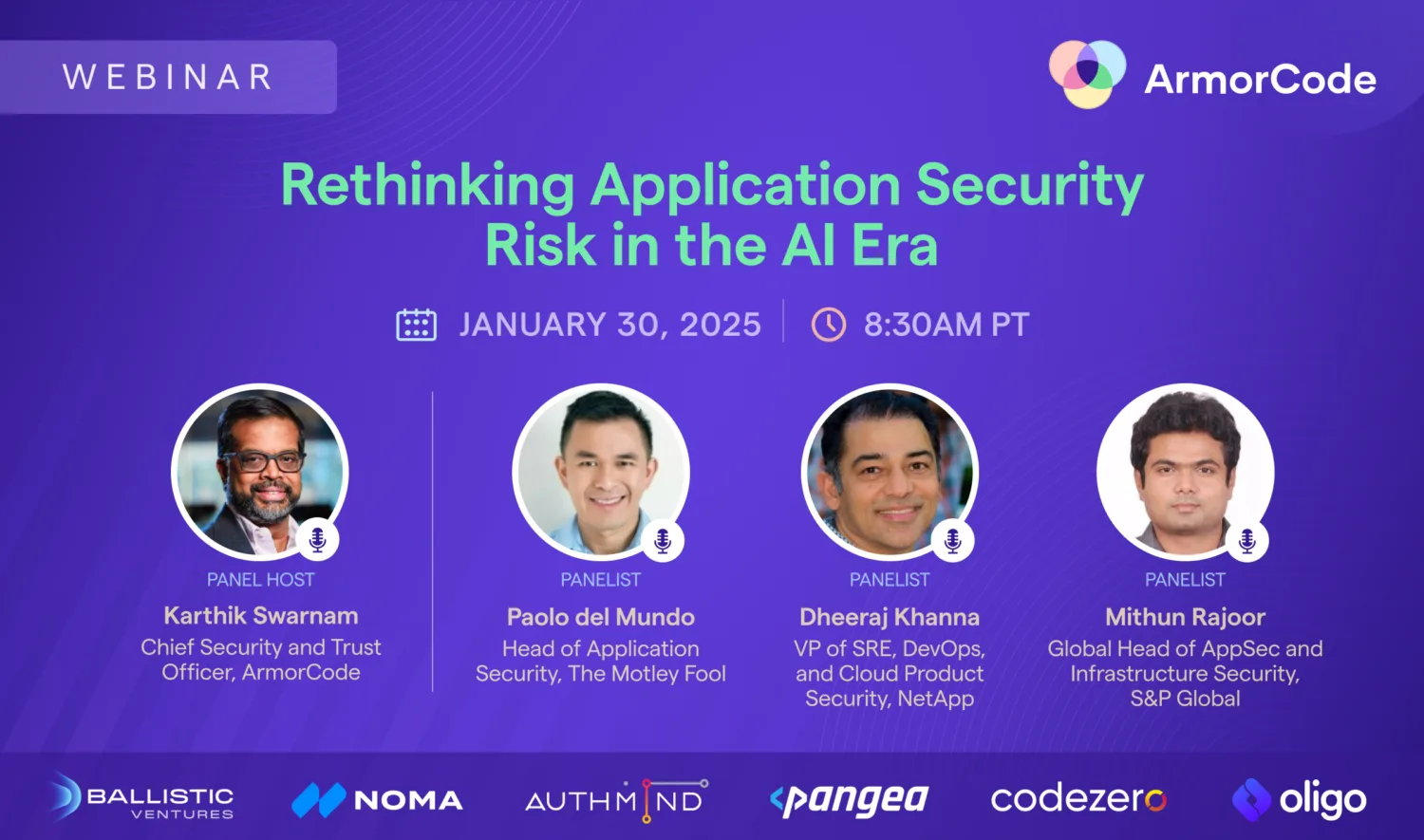Reduce Risk at Enterprise Scale: From Alert Fatigue to Strategic Security

As organizations scale at digital speed, cybersecurity directors face escalating pressure: the burst of vulnerabilities, growing noise from tools, and emerging threats, from supply chains to AI-generated code. The challenge is clear: how do you calculate real risk, not just scan results, and then drive it down at enterprise scale? That’s precisely the space ArmorCode’s ASPM (Application Security Posture Management) Platform addresses. Let me walk you through how ArmorCode calculates actual risk and helps you continuously reduce risk, with data, automation, and AI engineered for scale.
The Challenge: Too Many Alerts, Too Little Context
Your team likely runs a symphony of scanners, SAST, DAST, SCA, cloud posture tools, and container checks, to name a few. Collectively, these tools generate billions of findings. ArmorCode reports processing 25+ billion findings through 285+ integrations, including apps, infra, CI/CD, cloud, and more.
But raw numbers don’t equal business risk. Scanners often flag low-impact or false-positive vulnerabilities. Without context, every finding is a fire drill, which drains resources and delays response to truly critical issues. Worse, fragmented tooling leaves you managing silos, not risk.
ArmorCode’s Core Logic: Calculate True Risk with Unified Intelligence
ArmorCode moves beyond alert aggregation. Its risk engine ingests:
- All scans across your estate: apps, pipelines, build tools, infra.
- Contextual intelligence: business impact, threat intelligence, exposure, cloud risk surface, AI-generated code, supply chain dependencies.
- Enrichment layers: SBOM insights, runtime visibility, code ownership metadata.
By correlating and normalizing findings across domains, ArmorCode builds a comprehensive risk profile, prioritizing the vulnerabilities that matter most. This platform isn’t just a scanner processor; it redefines how risk is scored and surfaced.
Amplifying Security Teams with Agentic AI
Meet Anya, the industry’s first agentic AI Virtual Security Champion tailored for ASPM. Anya contextualizes risks, recommends remediation, and even writes runbooks, closing the gap between detection and action. Here’s what Anya brings to the table:
- Real-time vulnerability intelligence, as code pushes, dependencies change, or new threats emerge.
- Human-like recommendations enable developers to receive step-by-step guidance, not generic alerts.
- Orchestration across teams, driving tickets automatically to Jira, Jenkins, or ServiceNow.
- Continuous learning, combined with contextual feedback from developers, helps improve the efficacy of future detection and recommendation.
In practice, Anya enables teams to focus on high-risk issues while it handles noise and routine remediation plans.
Quantifying Risk Reduction: Metrics That Matter
ArmorCode customers report dramatic security improvements:
- 97% faster remediation. MTTR is reduced from months to days.
- 80%+ reduction in security technical debt through grouped ticket automation and developer visibility.
- 100% visibility across application, cloud, and infra layers, eliminating blind spots.
One global retail firm echoes the impact:
“We’ve reduced the need for dedicated resources by 90%, freeing up valuable time.”
This is real ROI: a quantifiable drop in organizational risk and faster time to value.
End-to-End Workflow to Reduce Risk
Here’s how the risk lifecycle looks with ArmorCode:
| Step | ArmorCode Capability | Outcome |
| 1. Ingest | Plug into 285+ scanners & CI/CD pipelines | Holistic dataset of findings |
| 2. Enrich & score | Correlate findings with business and threat metadata | Risk-first prioritization |
| 3. AI coach | Anya suggests intelligence-driven remediation | Security leader and developer-friendly guidance |
| 4. Automate workflow | Automated ticketing, grouping, and assignment | MTTR reduction & transparency |
| 5. Track & govern | Unified dashboards, risk metrics, and audit trails | Exec-level visibility & compliance |
| 6. Repeat | Continuous scans & AI feedback loops | Incremental posture improvements |
This isn’t theoretical; it’s how NetApp, Shutterfly, S&P Global, and others are modernizing their AppSec and DevSecOps operations.
Strategic Benefits for Cybersecurity Directors
As a cybersecurity director, these translate into concrete wins:
- Business-aware security: Visibility and risk context enable more informed decisions and prioritized investments.
- Efficiency gains: Developers work smarter, less rework, clearer direction, and automated sprint integration.
- Technical debt burn-down: Sweep away legacy flaws and false positives with systemic remediation (e.g., 80%+ debt reduction).
- Compliance & audit readiness: Risk metrics and control dashboards streamline reporting to the board and audit teams.
- Vendor consolidation: Instead of adding scanners, ArmorCode centralizes intelligence, reducing tool sprawl.
Addressing Emerging Risk Areas
ArmorCode isn’t static; it evolves with modern threat surfaces:
- AI‑generated code: Surveys show 76% of partners prioritize ASPM amidst generative-AI–driven development, and 92% report insecure code from AI. ArmorCode spots and signals these gaps via AI Code Insights, flagging blind spots in repos and pipelines.
- Software supply chain: With 84% of enterprise breaches tied to supply chain vulnerabilities, ArmorCode monitors SBOMs, dependency risks, and enforces policy across third-party components.
- Pen test integration: Findings from pentests are fed into the same risk engine, eliminating isolated silos. Shutterfly uses ArmorCode’s Pentest Management Module to track and act on findings in the same unified hub.
- Independent governance: The platform consolidates tool output without replacing them, so your existing investments remain valuable while ensuring unbiased, vendor-agnostic risk measurement.
Governance & Compliance Support
ArmorCode equips directors with dashboards and audit trails to align with frameworks such as ISO, PCI, SOC 2, and NIST. Through real-time reporting and comprehensive risk scoring, you can:
- Display trending vulnerabilities and remediation velocity.
- Run drill-downs on business-critical assets vs. risk exposure.
- Demonstrate continuous compliance postures to regulators and the board.
Why ArmorCode, Why Now?
The industry shift is undeniable:
- ASPM adoption is now the top investment focus for 2025 (76%).
- AI-generated code reshapes AppSec. With 65% believing AI will transform security in the following year. You need systems that monitor AI code and guard against hidden risk.
- Organizations recognize that the AppSec leader’s role is increasingly strategic, now more than ever.
ArmorCode bridges tool fragmentation with independent governance, enabling directors to drive real-world efforts to reduce risk without disrupting development velocity.
Next Steps & Recommendations
To operationalize this approach in your organization:
- Map your tool inventory, list scanners, CI/CD pipelines, code repos, and cloud infra.
- Set risk baselines, track MTTR, backlog debt, and team remediation efficiency.
- Engage ArmorCode for a pilot focused on a business-critical app and a high-risk infra path.
- Measure impact, compare week‑over‑week improvement in risk metrics.
- Scale enterprise‑wide, then use insights to align budgeting and maturity roadmap.
Key Takeaways
As a sales engineer, I see that ArmorCode isn’t just another vulnerability manager; it’s the nerve center that measures, forecasts, and most importantly, reduces real risk across your software ecosystem. It answers:
- “Which vulnerabilities matter most?” → Business‑aware prioritization.
- “What should my team fix?” → Remediable guidance and workflows.
- “How fast are we reducing risk?” → Metrics that validate progress.
- “Can I scale without disruption?” → Integrations that power velocity, not slow it.
- “Do I have governance proof for execs, auditors, regulators?” → Comprehensive dashboards and reports.
Cybersecurity directors face an intricate landscape: faster deployments, AI-generated code, fractured toolchains, and ever‑evolving threats. ArmorCode addresses this complexity with a unified, AI-driven platform that calculates true risk and closes the loop, effectively and measurably securing your critical assets.
Interested in Seeing It Live?
Let’s discuss how ArmorCode can map your current scan ecosystem, pilot on a high-value product stream, and deliver demonstrable reduction in technical debt and risk over 30–90 days. My team and I would be happy to coordinate a demo or a deeper architectural conversation for you.
Request a demo to get started.
References
Customers report 97% faster remediation, 80%+ reduction in technical debt, 100% visibility (armorcode.com/customer-stories)
76% of companies rank ASPM as top investment in 2025; 92% report insecure AI-generated code; 84% cite supply chain threats (businesswire.com)


